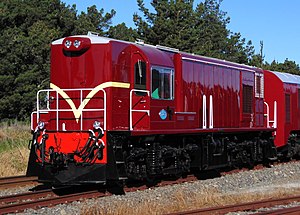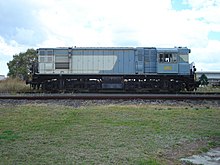Service
Three members of the class originally operated in the South Island, mainly on the Main North Line between Christchurch and Picton, while the other two members started life in the upper North Island. [3] In May 1969, all members were transferred to work in the Bay of Plenty area on the lightly laid track there. [3]
After the Kaimai Tunnel opened in 1978, all five members were transferred to the South Island for service in the Dunedin area. The class performed sterling service on the hilly Dunedin - Palmerston section of the Main South Line, and were also used to haul the Makareao branchline stone trains to Makareao due to their full adhesion Co-Co wheelset arrangement. [3] Members of the class occasionally made trips to Invercargill and were sometimes used on the Otago Central Line. [3]
Renumbering
In 1979, the computerised Traffic Monitoring System (TMS) was introduced, and the locomotives were renumbered as 1808, 1814, 1820, 1837 and 1843 respectively. [4]
South Island
They remained in Dunedin until 1984 - 1986, when they went north to Wellington and Napier mainly being used for shunting duties. [3] The locomotives were also used on revenue and special passenger services over the years of their operation. [3]
This page is based on this
Wikipedia article Text is available under the
CC BY-SA 4.0 license; additional terms may apply.
Images, videos and audio are available under their respective licenses.


